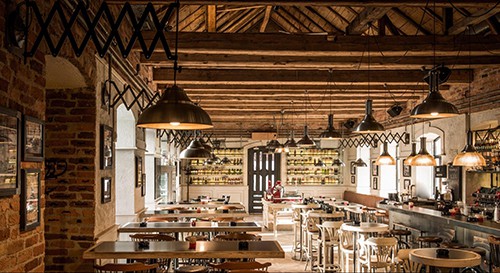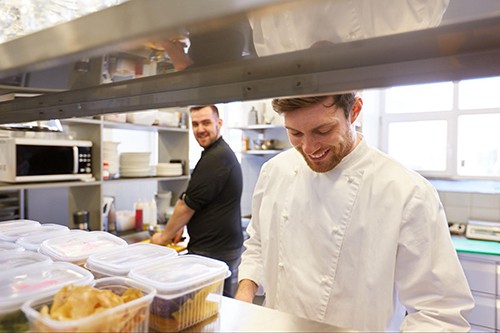20 Proven Tips For First-Time Managers
Becoming a manager for the first time is exciting. You’re being recognized for...

If opening a restaurant is in your future, you are undoubtedly excited — and perhaps feeling a bit overwhelmed. If that’s you, don’t worry. This step-by-step guide will break things down and help you determine the direction that’s right for you.
We’ll discuss how to navigate the early planning stages, review some essentials to take care of before launch day arrives, and leave you with some tips to keep your restaurant running smoothly once it opens.

We’ve all heard the phrase, “When you fail to plan, you plan to fail.” This is especially true when it comes to opening a restaurant. You can’t just wing it and hope everything comes together.
To best set yourself up for success, start by taking time to complete the following steps.
“Restaurant” is a word encompassing a wide variety of venues, from bistros to fine dining establishments and even ghost restaurants. With so many different options, what’s your restaurant concept?
If you’re not sure yet, ask yourself these questions to start defining it:
As you ponder your answers, use them to draft a written concept for your restaurant. You’ll need this as you move forward with your opening.
Every city has requirements and health codes for restaurants. Before you continue the process of opening a restaurant, do your homework on local laws and rules to avoid getting into hot water.
The Small Business Administration is a good place to look, and you should plan to speak with your legal counsel for more guidance.
A business plan is a blueprint for your eatery. It can also become a powerful tool to help you get funding for your new venture.
As such, it should include information about your restaurant’s:
It may take some time to develop and write your business plan, but doing so is a crucial step in the launch process.
Once your business plan is in place, it’s time to find the funds you need to make your restaurant dreams come true. This could mean leveraging your personal resources, applying for a loan, or seeking investors.
When you’ve got cash in hand, it’s time to take the next step and find the spot that will soon turn into your restaurant.
Since location is crucial in this industry, you’ll want to scout out the possibilities. A successful eatery needs to be in an area with plenty of foot traffic and visibility from passersby. Look for spaces near other popular restaurants, transportation hubs, or entertainment venues.

Now that the wheels are all in motion, it’s time to shift your gears a bit and set your restaurant up for a successful opening day.
First impressions matter, which means it’s essential to put thought into your interior design. Think about the ambiance you want the restaurant to reflect, and keep it in mind as you make decisions.
Carefully choose each design element, from the tables to the signage. You want everything to be a good fit with the concept you’re going for.
As you start furnishing your restaurant, watch out for potential bottlenecks and areas that could be hazardous.
Your restaurant’s menu is the heart of its identity. It should feature high-quality dishes that customers will love and find unique.
However, remember that you’ll need to source all of the ingredients and equipment required for each menu item. A massive menu may not be the best idea, as it might lead to unused or spoiled inventory.
Keep it simple, at least at first. You can always add more menu items later. And as you plan, review your pricing strategy. Price every item so that it makes a profit while remaining competitive in your market.
No matter how good your menu is, you can’t prepare anything without the right ingredients and supplies. Your success often depends on having fresh products coming in daily from reliable vendors.
Shop around to find suppliers that can get you everything you need at a reasonable price. You may need to work with multiple companies to stick to your budget.
It can be difficult to run a restaurant alone. A solid team can help create a quality dining experience for everyone who walks in the door.
Be clear on your staffing needs and requirements before you start hiring. Review your schedule and note how many people you need for each shift. You don’t want to be over- or understaffed.
During this stage, draft your job descriptions carefully to attract the right people. When interviewing applicants, look for someone who meshes well with your restaurant culture.
Once you’ve hired a great team, you can take advantage of the Sling app to help manage everyone. Use it for tasks such as:
Create a buzz about your restaurant by getting the word out. Consider running ads and promotional campaigns on social media. Take plenty of behind-the-scenes photos and film short videos to give people a sneak peek. Shots showcasing your delicious food will also be a hit.
But as you grow your online presence, don’t forget about more traditional advertising platforms, like local radio stations and community bulletin boards. They’re still good ways to drum up some noise and excitement, especially if you include discounts or coupons.
Make everyone eager to taste what you have to offer.

Your hard work paid off and brought your business to fruition. However, your job isn’t over yet.
Now it’s time to focus on continued growth to ensure your place remains successful. The steps below can help with that.
Your day-to-day operations can make or break your business, so monitor them closely.
Here are some metrics to consider tracking:
Keeping track of data is an essential part of running a restaurant. But if you try to document it all by hand, paperwork can consume your time.
To help free you up, streamline this part as much as possible with software. For instance, consider using the Sling suite of tools to review your labor costs and ensure adequate coverage before a busy shift.
Once you have a plan and tools in place for collecting the necessary data, take time to review it regularly. This allows you to recognize problems as they arise and proactively correct them.
Internet resources like Google, Yelp, and TripAdvisor are the first places diners will go before deciding where to eat. Continued growth depends heavily on maintaining a positive reputation on these and other websites, so don’t ignore them.
Make it a habit to read your reviews every week. When someone leaves a glowing review, take a moment to reply and thank them. Doing so shows that you care.
When someone leaves a bad review (and, yes, it will happen), don’t get angry or argue with the person online. Instead, reply politely, apologize for the bad experience, and offer to fix it if they give your restaurant another chance.
Social media is another means of managing your restaurant’s reputation. You don’t need to be on every platform, but having one or two active accounts (e.g., Instagram and Facebook) can provide exposure that you can’t get anywhere else.
What should you do with these platforms? Post photos of your daily specials, introduce your staff, and share behind-the-scenes videos of what’s going on in the kitchen.
This can help make your business feel more welcoming and those who work there more human and approachable.
When potential customers see attractive food and happy employees on their screens, they’ll be tempted to come in and experience your restaurant for themselves.
Getting a new customer to walk through your door is great, but getting them to come back a second or third time is where the real magic happens.
In the restaurant business, your regulars (i.e., the people who visit often) are the backbone of your success. They are the ones who will keep you afloat during slow months and tell their friends about your delicious food.
So, how can you turn new guests into regulars? Start a loyalty program that rewards customers for spending money at your business.
Your program can be as simple as a paper punch card where customers buy ten food items and get the eleventh one for free. Or, it can be as elaborate as an app that tracks points automatically and provides rewards accordingly.
The goal is to give people a reason to choose your restaurant over the competition. When a customer knows that they are close to earning a discount on their food, a free appetizer, or a free drink, they’ll be much more likely to stop by.
If you want to take it a step further, make connections and build a community. Consider collecting email addresses from your customers and putting out a monthly newsletter.
Within the newsletter itself, avoid spamming them with ads. Instead, give them a coupon for a free dessert, tell them about upcoming specials, and/or introduce them to the new chef or hostess.
This keeps your business in their minds even when they aren’t hungry.
When you first open your restaurant, the menu is brand new and exciting. However, after a year or so, things can start to feel a little stale.
To keep things fresh (and profitable), see your menu as a living thing that grows, changes, and evolves over time.
This doesn’t mean that you get rid of customer favorites that are making money. Instead, it means being smart about what you sell and when you sell it.
One of the best ways to do this is to embrace ingredients like fruits and vegetables that are “in season” at a specific time of the year.
For example, using strawberries in the summer and squash in the fall usually costs less than using strawberries in the fall and squash in the summer. Plus, fruits and vegetables just taste better at the end of their proper growing season.
By offering seasonal specials based on local produce, you create new reasons for customers to visit your restaurant every few months, and it keeps your kitchen staff excited and engaged because they get to cook new things and use different ingredients.
For more ways to build a great menu, check out these articles from the Sling blog:
At some point, when your restaurant hits its stride, you’ll reach the limit of how much money you can make. You only have a certain number of tables and chairs, and you can only serve so many people during the hours you’re open.
To continue growing, explore new revenue streams that don’t depend on a customer sitting at a table inside your restaurant. Catering is one of the most common ways to do that.
Local businesses often need lunch for meetings, and families need food for parties or weddings. If you can package your popular dishes in large trays, you can sell food to fifty people at once without dirtying fifty plates in your dining room.
Providing food to events outside your restaurant can bring in a lot of extra cash without requiring you to pay for more wait staff.
Another option for a new revenue stream is merchandising. If your restaurant has a cool logo, slap it on a shirt, hat, or mug and see what sells. Or if your restaurant has a “famous” sauce, consider bottling it and selling it at the front counter.
Items like these serve two purposes: they bring in extra money, and they act as “walking” advertisements for your brand. When a customer wears a hat with your logo on it or uses your sauce at a family meal, they’re introducing your restaurant to new people.

Opening a restaurant doesn’t have to be daunting. The steps above can help you break the process down into bite-sized chunks that don’t feel as overwhelming. And once you’re open, Sling can help keep things running smoothly.
This powerful software has features any restaurant owner would appreciate. It’s one of the best ways to optimize your workforce schedule and track labor costs.
Features include:
For more resources to help you manage your restaurant, visit GetSling.com today.
See Here For Last Updated Dates: Link
This content is for informational purposes and is not intended as legal, tax, HR or any other professional advice. Please contact an attorney or other professional for specific advice.
There are pros and cons to both options.
When starting from scratch, you can save money in a variety of ways and can get creative with the menu and decor (all things you can’t do when you buy a franchise). That said, you have to create a brand-new business plan and build your brand from the ground up.
When buying a franchise, you get a ready-made menu, brand name, and business plan that already works. That said, buying a franchise is more expensive because you have to pay an upfront fee and a portion of your sales to the company every month.
Do plenty of research on both options before making your decision.
One of the best ways to save money when starting a restaurant is to buy used kitchen equipment.
Commercial appliances, like heavy-duty ovens, mixers, and stainless steel prep tables, are built to last for a long time. So, just because they’ve been used in another kitchen doesn’t mean they’re past their useful life.
As a general rule, the smart buys are simple items like sinks and tables because they have the fewest moving parts. Be a little more wary of complex machines like refrigerators and ice makers. If they break, the repair costs might be higher than buying new.
If you’re in the market for used kitchen equipment, you can find great deals at restaurant auctions or used supply stores.
A soft opening is a practice run you conduct before your official opening day. Instead of opening to the public all at once, you invite only friends, family, or local business owners to eat at your restaurant for a few days.
Holding a soft opening is highly recommended for a new restaurant because it allows you to identify problems in the kitchen or service without upsetting paying customers, give your team plenty of practice in a lower-stress environment, and test the menu more extensively.
Most soft openings are run in one of three ways: free food to build goodwill, discounted prices, or full price with a perk like a free drink to sweeten the pot.
Either way, the event may cost your business a bit of money up front, but the practice you provide for your team and the good word of mouth you generate can be invaluable in the long run.
Schedule faster, communicate better, get things done.